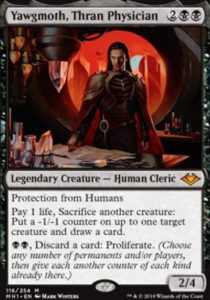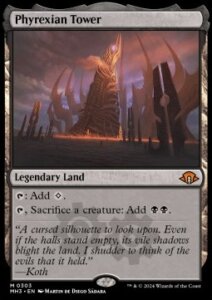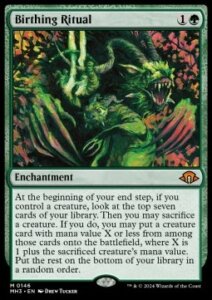If you are new here, don’t forget to check our Discord Channel. It’s free for everyone!
Introduction
Heading into MH3, Yawgmoth was coming off of a stellar year. The deck had received significant upgrades from recent sets (Delighted Halfling, Orcish Bowmasters, Agatha’s Soul Cauldron, etc.) and the banning of Fury, Violent Outburst, and Up the Beanstalk removed some of the more difficult matchups. Yawgmoth was finally considered one of Modern’s best decks. However, the time at the top was short-lived. Modern Horizons III introduced a new creature combo deck based around Nadu, Winged Wisdom. Nadu was both faster and more resilient than Yawgmoth, and quickly became the best deck in the format. While Nadu was legal, it was hard to justify playing any other strategy if your goal was to win games. As many players expected, Nadu’s time in Modern was short; the menacing Bird was removed from Modern in the most recent B&R announcement. This is a great boon for Yawgmoth, as it should once again be the best creature-based combo deck in Modern. In addition to Nadu, Grief was also banned. Goryo, Necro and Living End may continue to see play, but at the very least they’re weaker than before. The banning of Grief is probably a net negative for Yawgmoth’s position in the metagame, since Grief was good at punishing out the linear strategies that Yawgmoth has historically struggled against. Despite this, I think Yawgmoth is poised for a comeback and still has the potential to be one of the best decks in Modern.

Prior to MH3, the core of Yawgmoth consisted of 22 lands and 32-35 nonland cards. All of the best cards for Yawgmoth synergized well together and formed a cohesive deck, leaving only a few slots for customization. This is no longer the case. Yawgmoth pilots have settled on two different versions of the deck that only share Yawgmoth, Thran Physician, Young Wolf, Orcish Bowmasters, and Chord of Calling as the core spells. The first build is Rumble Yawg, which incorporates Malevolent Rumble into the pre-MH3 version of the deck. The second is Ritual Yawg, which is based around maximising the potential of Birthing Ritual. Sample decklists for both versions are shown below, followed by an in-depth discussion of the new cards that see play in each version.
Ritual Yawgmoth:
Rumble Yawgmoth:
New Inclusions
Birthing Ritual
Birthing Ritual turned out to be one the most impactful cards for Yawgmoth out of MH3; it led to the formation of an entirely separate version of the deck. Many players (myself included) were sceptical of it initially. Ritual has harsh deck building requirements, synergizes poorly with Grist, the Hunger Tide, and competes for the same noncreature slots as Agatha’s Soul Cauldron. Even though these concerns turned out to be true, Birthing Ritual was still powerful enough to replace these former staples and restructure how Yawgmoth was built. Ritual incentivises playing creatures that leave behind value when they are sacrificed. Orcish Bowmasters already fit this mould perfectly. Former staples like Wall of Roots and Blood Artist/Zulaport Cutthroat were replaced with Prosperous Innkeeper and Marionette Apprentice. Most of the copies of Grist, The Hunger Tide were replaced with an assortment of three drops, such as Endurance, Fulminator Mage, Geralf’s Messenger and others. While these three drops seem underpowered for Modern, it is essential to have enough creatures that can be sacrificed to Ritual to find Yawgmoth. Since the deck was no longer running Wall of Roots and very few copies of Grist, it makes sense to cut Agatha’s Soul Cauldron as well. All of these changes lead to a deck that no longer resembles the former version of the deck.
Malevolent Rumble
Unlike Birthing Ritual, Malevolent Rumble slots in perfectly into the old version of Yawgmoth. Rumble digs four cards deep, and the Scion token can be immediately sacrificed to refund half of the mana spent to cast the spell. Yawgmoth makes use of the 0/1 body better than most decks, since it can be sacrificed to Grist or Yawgmoth and is another body for casting Chord of Calling with Convoke. Rumble also fills the graveyard for Agatha’s Soul Cauldron and often enables Delirium for Shifting Woodlands by itself. The main downside of this card is that it synergizes poorly with Birthing Ritual, which needs a high density of actual creatures to continue the chain. As such, Malevolent Rumble is only played in Rumble Yawgmoth.
Marionette Apprentice
A better version of Blood Artist/Zulaport Cutthroat has been at the top of my Yawgmoth wishlist for a long time. Unfortunately, Apprentice doesn’t replenish our life like the aforementioned cards. Nevertheless, it is still a strong option in Yawgmoth, as generating multiple bodies out of a single card is quite valuable for the deck. Multiple Apprentices can quickly pressure your opponent and dissuade them from killing our creatures. The extra body also synergizes well with Birthing Ritual, which makes Apprentice even better in that version of the deck.
Accursed Marauder
Accursed Marauder is the first printing of a two mana Edict attached to a creature. Edicts have periodically seen play in Yawgmoth’s sideboard as a way to answer problematic creatures. Marauder is superior to the other edicts because it can be found by Chord of Calling or Birthing Ritual. Accursed Marauder is most commonly seen in the sideboard of Ritual Yawgmoth.
Boggart Trawler
MH3 added 20 new MDFCs to the format. Even if the spell side is slightly overcosted or underpowered for Modern, MDFCs that can enter as untapped lands should always be considered. The only MDFC that has found a place in Yawgmoth is Boggart Trawler. As a three drop creature, it helps decks with Birthing Ritual maintain a high creature count. Trawler also does an adequate Endurance impression against opposing graveyard strategies when found off of Chord of Calling. However, there are some downsides to Boggart Trawler. Paying life is especially painful for this deck, since Yawgmoth uses life as a resource. Additionally, the mana base isn’t equipped to play more than 3-4 sources that don’t produce green mana. For these reasons, both versions of the deck play a couple copies of Boggart Trawler at most.
Shifting Woodlands
Shifting Woodlands is an on-colour utility land with a powerful effect in the mid-late game. Woodlands pairs best with Malevolent Rumble, which fills the graveyard and is a Sorcery to help enable Delirium. Yawgmoth is often the best target for Woodlands, though there are also spots where it copies a utility creature or Cauldron. The ability to copy a milled Yawgmoth is especially powerful in blue matchups to play around Counterspell and Subtlety. Grist is not a good target for Woodlands; a Woodlands that copies Grist has 0 loyalty and immediately dies. Copying Cauldron is also less good since Woodlands does not remember any of the cards that it exiled on previous turns. Woodlands is a staple in Rumble Yawgmoth, with the deck often playing 2 copies. Ritual Yawgmoth struggles to get delirium reliably, which makes Pendelhaven a better utility land for this version.
Cards from other sets
The sweeping changes from Modern Horizons III has incentivised players to incorporate cards from previous sets into various decks, including Yawg. Arboreal Grazer often sees play in Ritual Yawgmoth as a dork that leaves behind value after it is sacrificed. Ritual Yawgmoth has also incorporated a few copies of The One Ring as an additional value engine. Both versions sometimes run tutor targets such as Collector Ouphe, Gaddock Teeg, and Suncleanser out of the sideboard. Sweepers like Meathook Massacre, Culling Ritual, and Path of Peril are commonly played in the sideboard to combat the Energy. Damping Sphere is an excellent tool against both big mana decks and Ruby Storm. Abrupt Decay currently lines up well against the commonly played noncreature permanents. Erebos, God of the Dead also saw some play in the sideboard as an answer to Necro. As the format continues to change, expect to see more targeted answers from previous sets in Yawgmoth’s sideboard.
Cards that didn’t make the cut
There were many other cards from MH3 that seemed promising for Yawgmoth. After extensive testing, here are the cards that didn’t make the cut.
Flare of Cultivation and Phyrexian Tower

Initially, it looked like these two cards would easily find a home in Yawgmoth. The deck already plays a handful of expendable creatures to sacrifice to both cards. Flare and Tower could mimic the acceleration of mana dorks without being vulnerable to early removal. Flare also makes the deck incredibly resilient to Blood Moon style effects. However, both cards vastly underperformed expectations. Sacrificing creatures other than Young Wolf was problematic, as there were often not enough creatures in play to fuel Yawgmoth. Outside of a turn two Grist, there isn’t a great use for the ramp in the early game and Yawgmoth rarely needs more mana in the later stages of the game. The failure of these cards taught me a valuable lesson: Yawgmoth doesn’t want to trade creatures for mana.
Spymaster’s Vault
Even though the effect is powerful, there is little room in the mana base for lands that don’t produce green mana. Play Boggart Trawler instead and leave this card for decks that are more heavily committed to black.
Springheart Nantuko
While it was great in Nadu, Springheart Nantuko underperformed in Yawgmoth. You always want to immediately follow up Nantuko with a land, which makes the card closer to a three drop than a two drop. It is also a poor topdeck, since Yawgmoth rarely has the luxury of holding lands. It doesn’t have an activated ability for Cauldron and can’t be sacrificed for value with Ritual. Nantuko was the best in versions with Flare of Cultivation or Wight of the Reliquary, but neither of these cards made the cut either.
Chthonian Nightmare
When MH3 was first released, Chthonian Nightmare saw a considerable amount of play in Yawgmoth. The ability to consistently recur creatures was especially valuable in Ritual Yawgmoth, since many of the creatures have ETB abilities. It was especially potent when paired with Fulminator Mage to destroy all of your opponents lands. Over time, Nightmare’s flaws became more apparent. The Modern metagame rewards interacting early and Nightmare is often useless in the first few turns. Additionally, Nightmare requires a large mana investment to slowly accrue value. Nightmare has been replaced by The One Ring in a lot of Ritual lists, and Rumble lists prefer Agatha’s Soul Cauldron. Even though I think that Nightmare is currently suboptimal, it is still a powerful late game engine and sees some play in Ritual Yawgmoth.
Eladamri, Korvecdal
Prior to release, Eladamri received a decent amount of praise as a version of Elven Chorus that can be found by Chord of Calling. The main strength of Elven Chorus is that it was nearly impossible to remove once it was on the battlefield. Eladamri is a conduit for removal and doesn’t leave behind value when it is sacrificed to Ritual.
Six
Much like Eladamri, Six is another value three drop that doesn’t generate value when it is sacrificed. Additionally, Yawgmoth rarely has a surplus of lands to utilise the retrace ability.
Wight of the Reliquary
As discussed above, Yawgmoth rarely wants to trade creatures for mana. Wight isn’t impactful enough to fit into Rumble Yawgmoth and Ritual Yawgmoth wants to play creatures that leave behind value when they are sacrificed.
Warren Soultrader
Warren Soultrader suffers from many of the same problems as Wight of the Reliquary. Soultrader is better suited for a deck that maximises its potential instead of as a role player in Yawgmoth.
Thief of Existence
Thief of Existence has a powerful effect attached to a decently sized body. If the ability triggered on ETB instead of on cast, this card would have seen play as a tutor target. As it stands, there is no reason to play this card.
Sylvan Safekeeper
Sylvan Safekeeper seems like the perfect card for Yawgmoth, since it can be found with Chord to counter removal spells. Unfortunately, Safekeeper is a Human and cannot give protection to Yawgmoth.
What are the Strengths and Weaknesses of each version?
Rumble Yawgmoth

Strengths
- The deck’s play patterns resemble pre-MH3 Yawgmoth. Players who have played Yawgmoth previously will have an easier time finding the best lines.
- Malevolent Rumble smooths your draws, comes with an extra body, and fills the graveyard for both Cauldron and Shifting Woodlands.
- Four copies of Grist, the Hunger Tide. Grist excels against large problematic creatures (Phlage, Murktide, Psychic Frog, Sheoldred) as well as commonly played sweepers (Wrath of the Skies, Supreme Verdict, Pyroclasm, and Kozilek’s Return).
- The deck is very resilient to counterspells. Halfling makes Yawgmoth, Grist, and Cauldron uncounterable. It is also relatively easy to enable delirium for Shifting Woodlands to copy a countered Yawgmoth or Cauldron.
- Agatha’s Soul Cauldron opens up additional combo lines with Walking Ballista and Young Wolf that can be executed when your life total is under pressure. Cauldron is good against opposing graveyard-based strategies and dodges All is Dust and Devourer of Destiny from Eldrazi decks.
Weaknesses
- Cauldron can be underwhelming when it is not drawn in conjunction with support cards like Rumble or Grist to fill the graveyard. Similarly, Grist is weak against linear decks.
- The inclusion of Cauldron and Woodlands makes the deck much more vulnerable to graveyard hate.
- Targeted sideboard cards like Cursed Totem and Damping Matrix are very effective at shutting down the deck. Only Grist is able to operate effectively when one of these cards is in play.
- Artifact removal is much more common than enchantment removal, especially in the main deck. Cauldron is a liability against cards like Flame of Anor or Kolaghan’s Command.
Ritual Yawgmoth

Strengths
- The deck is easier to pilot competently if you are picking up Yawgmoth for the first time. Both The One Ring and Birthing RItual generate a ton of value and help make up for small play errors.
- Birthing Ritual enables a potent beatdown plan that can win games without Yawgmoth. This makes the deck much less vulnerable to graveyard hate, extraction effects on Yawgmoth, and dedicated sideboard cards like Cursed Totem.
- Ritual Yawgmoth mulligans less. The deck’s payoffs don’t need additional support cards to function; single payoff hands with Ritual, Yawgmoth, Chord, or Ring when supported by creatures and lands are all reasonable keeps.
- The deck also mulligans very well. A four card hand with Young Wolf, Birthing Ritual, and two lands still has a reasonable chance to win the game.
- The deck is good at quickly finding singleton copies of cheap hatebears such as Collector Ouphe, Suncleanser, Soulless Jailer, or Gaddock Teeg.
Weaknesses
- The deck is much more susceptible to sweepers. Wrath of the Skies and All is Dust wipe the entire board (including Ritual) and cards like Pyroclasm or Kozilek’s Return effectively neuter the beatdown plan.
- Without multiple copies of Grist, the deck can struggle to remove large threats.
- It can be difficult to force through a Birthing Ritual against counterspells. Spell Snare in particular is very good against this version of Yawgmoth.
- There is a lack of powerful three drops for the deck. Cards like Honest Rutstein, Eternal Witness, Woe Strider, and Thought-Stalker Warlock don’t really match the current power level of Modern.
- Sideboarding with Ritual is challenging since the deck needs to maintain a high density of creatures at certain mana values to keep Ritual running smoothly. It is tricky to balance this while bringing in noncreature spells.
Final Thoughts
While both versions of the deck are good, I think that Rumble Yawgmoth is currently slightly better positioned in the Modern metagame. However, this could easily change as the metagame continues to settle after the most recent bannings. I hope this update has been a useful introduction to the new cards. I plan to publish an updated Yawgmoth primer along with a detailed sideboard guide once the Modern metagame has had time to stabilise.
